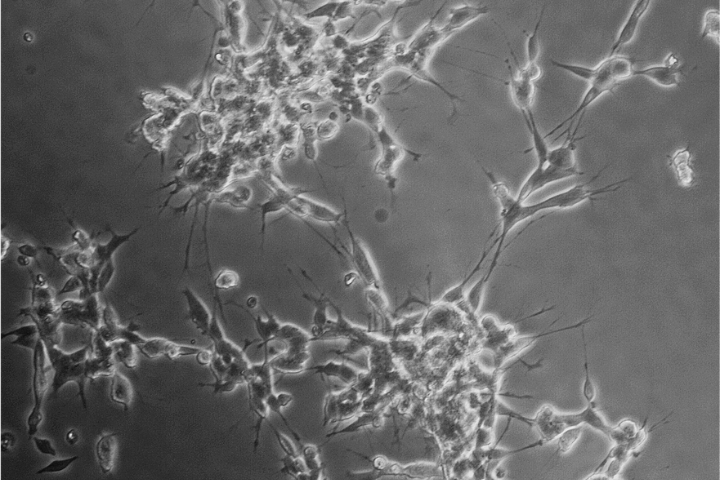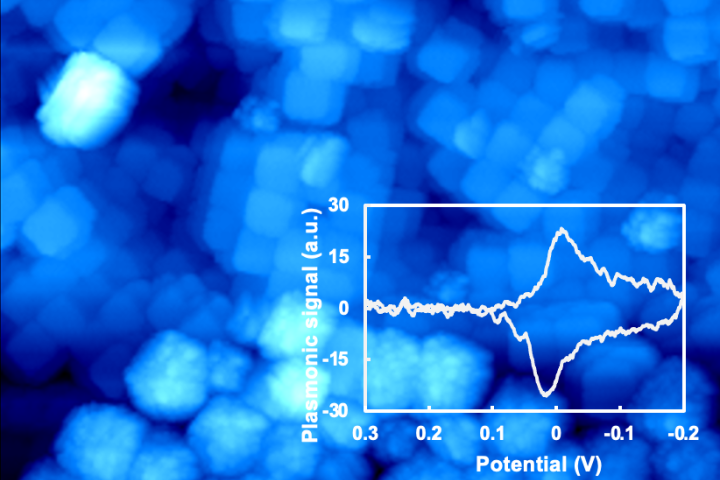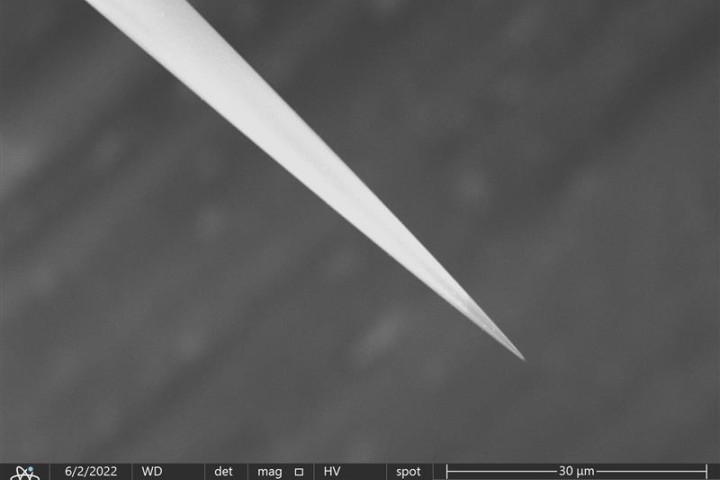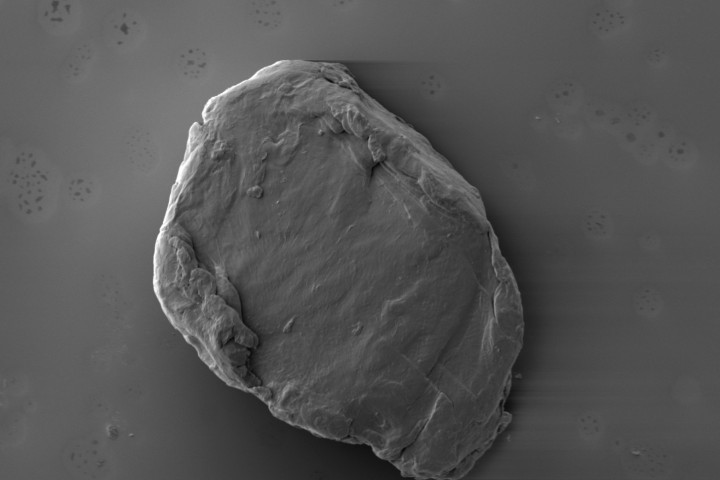Parkinson's Disease

Parkinson's Disease
Parkinson’s disease (PD) is a major neurodegenerative disorder involving dysfunction and death of dopaminergic neurons in the substantia nigra. A large body of evidence has suggested that misfolding and aggregation of α-synuclein, an abundant brain protein near presynaptic termini, leads to high neurotoxicity, and the intermediate aggregation forms, such as soluble oligomers, are considered to be most cytotoxic. However, the exact mechanism is still unclear. One hypothesis of the cytotoxic mechanism is that the α-synuclein aggregates insert into the lipid bilayer and disrupt the cell membrane’s integrity, leading to the permeabilization of lipid bilayers and eventually cell death, while many questions remain unanswered in this field. To better understand the mechanism, our group uses surface plasmon resonance microscopy (SPRM) to study the kinetics of interaction etween α-synuclein (monomers and aggregates) and living cell membranes and scanning ion conductance microscopy (SICM) to determine α-synuclein-induced morphological and mechanical changes and possible membrane disruption in real time on living cell membranes. Information collected from these new approaches are correlated with traditional approaches to provide new evidence in gaining new evidence in recognizing the reported mechanisms. This work is supported by NIH R15.
References:
- C. Feng, M. Flores, C. Dhoj, A. Garcia, S. Belleca, D. Abou Abbas, J. Parres-Gold, A. Anguiano, E. Porter, and Y. Wang* "Observation of Alpha-Synuclein Pre-Formed Fibrils Interacting with SH-SY5Y Neuroblastoma Cells Membranes Using Scanning Ion Conductance microscopy" ACS Chem. Neurosci., 2022, https://doi.org/10.1021/acschemneuro.2c00478
- J. Parres-Gold, A. Chieng, S. Wong Su, Y. Wang* “Real-Time Characterization of Cell Membrane Disruption by α-Synuclein Oligomers in Live SH-SY5Y Neuroblastoma Cells” ACS Chem. Neurosci., 2020, 11 (17), 2528-2534
- S. Wong Su, A. Chieng, J. Parres-Gold, M. Chang, Y. Wang* “Real-time determination of aggregated alpha-synuclein induced membrane disruption at neuroblastoma cells using scanning ion conductance microscopy” Faraday Discuss., 2018, 210, 131
Single Nanoparticle Electrochemistry

Single Nanoparticle Electrochemistry
Single-Entity Electrochemistry (SEE) refers to the electroanalysis of an individual unit of interest, such as a single cell, nanoparticle or molecule. SEE is essential for understanding the fundamental dynamics of real-world systems that are often heterogeneous. We use plasmonic electrochemical microscopy, an optical imaging based electrochemical technique, to study SEE at individual metallic and non-metallic nanoparticles. We are also developing new PEM-centered techniques to improve the feasibility, resolution, and sensitivity of PEM for SEE and to advance scientific progress in this field.
References:
- A. Garcia, K. Wang, F. Bedier, M. Benavides, Z. Wang, S. Wang, Y. Wang* "Plasmonic Imaging of Electrochemical Reactions at Individual Prussian Blue Nanoparticles" Front. Chem., 2021, 9, 718666
- A. Garcia, S. Wang, N. Tao, X. Shan*, Y. Wang* "Plasmonic Imaging of Oxidation and Reduction of Single Gold Nanoparticles and Their Surface Structural Dynamics" ACS Sens. 2020, 6 (2), 502-507
- Y. Wang, X. Shan, S. Wang, N. Tao “Plasmonic imaging of surface electrochemistry of single gold nanowires”, J. Am. Chem. Soc., 2017,139, 1376
Electrochemistry at Nanoscopic Interfaces

Electrochemistry at Nanoscopic Interfaces
We are interested in fundamental studies and sensing applications of electrochemistry at nanoscopic interfaces. There are two ongoing projects. The first one focuses on carbon nanoelectrodes and their applications in intracellular detection of electrochemically active species and chemical sensing. The second one focuses on understanding of interfacial-ion-transfer (IIT) kinetics at nanopipette supported interface between two immiscible electrolyte solutions (ITIES), which is part of the collaborative effort from a newly funded NSF Center for Chemical Innovation (CCI) aiming for enabling new ways to improve electrochemical technologies.
References:
- M. Chang, G. Morgan, F. Bedier, A. Chieng, P. Gomez, S. Raminani, Y. Wang* "Recent advances in nanosensors built with pre-pulled glass nanopipettes and their applications in chemical and biological sensing" J. Electrochem Soc. 2020, 167, 037533
- Y. Wang, T. Kakiuchi, F. Shigematsu and M. V. Mirkin “Kinetics of Ion Transfer at the Ionic Liquid/Water Nanointerface” J. Am. Chem. Soc., 2010, 132, 16945.
Environmental Applications

Environmental Applications
We are interested in applying analytical techniques in studying general environmental concerns such as particulate matter (PM) and microplastic pollution. Ongoing projects include (1) monitoring the effect of PM exposure on membranes of human lung cells and neuroblastoma cells using scanning ion conductance microscopy; (2) sampling and characterizing microplastics from LA coastal area; (3) monitoring the degradation of polyethylene terephthalate powder and its effect on adsorbing toxic organic compounds. The last two projects are supported by the new NSF CREST Center for Advancement toward Sustainable Urban Systems (CATSUS) at Cal State LA launched on September 1, 2022.
References:
C. Dhoj, A. Garcia, A. Manasyan, M. Benavides, D. Abou Abbas, C. Toscano, E. Porter, and Y. Wang* "Scanning Ion Conductance Microscopy Reveals Differential Effect of PM2.5 Exposure on A549 Lung Epithelial and SH-SY5Y Neuroblastoma Cell Membranes" Anal. Bioanal. Chem. 2023, DOI: 10.1007/s00216-023-04690-y